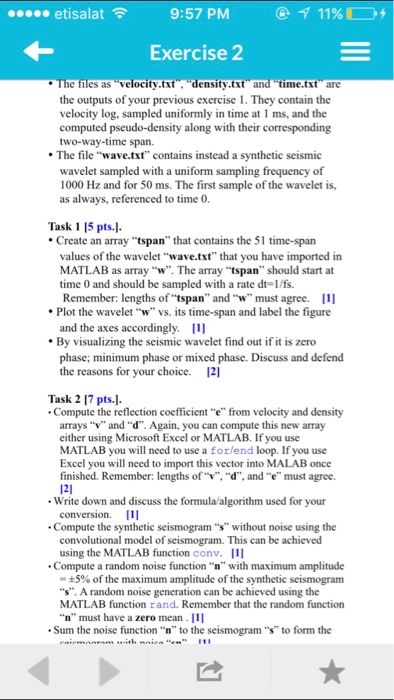Answered step by step
Verified Expert Solution
Question
1 Approved Answer
Calculate the reflection coeffiencents on matlab using velocity and density. Please just provide the general code for each task shown in the image. Need extra
Calculate the reflection coeffiencents on matlab using velocity and density. Please just provide the general code for each task shown in the image. Need extra help writing the matlab loop 
etisalat 9:57 PM Exercise 2 xt, "density.txt time.txt are the outputs of your previous exercise 1. They contain the velocity log, sampled uniformly in time at 1 ms, and the computed pseudo-density along with their corresponding two-way-time span. The file "wave.txt" contains instead a synthetic seismic of wavelet sampled with a uniform sampling frequency 1000 Hz and for 50 ms. The first sample of the wavelet is, as always, referenced to time 0. Task 1 15 pt . Create an array tspan" that contains the 51 time-span values of the wavelet "wave.txt" that you have imported in MATLAB as array "w". The array "tspan" should start at time 0 and should be sampled with a rate dt-1/fs Remember: lengths of tspan" and "w" must agree. 1l Plot the wavelet "w" vs. its time-span and label the figure and the axes accordingly. 1I By visualizing the seismic wavelet find out if it is zero phase; minimum phase or mixed phase. Discuss and defend the reasons for your choice. 121 Task 2 17 pts.] Compute the reflection coefficient "e" from velocity and density arrays "v" and "d". Again, you can compute this new array cither using Microsoft Excel or MATLAB. If you use MATLAB you will need to use a forlend loop. If you use Excel you will need to import this vector into MALAB once finished. Remember: lengths of"d", and "e" must agree. 121 Write down and discuss the formula/algorithm used for your conversion. 1 Compute the synthetic seismogram "s" without noise using the convolutional model of seismogram. This can be achieved using the MATLAB function conv. [1 Compute a random noise function "n" with maximum amplitude -5% of the maximum amplitude of the synthetic seismogram "s". A random noise generation can be achieved using the MATLAB function rand. Remember that the random function n" must have a zero mean 11 Sum the noise function "n" to the seismogram "s" to form the 
Step by Step Solution
There are 3 Steps involved in it
Step: 1

Get Instant Access to Expert-Tailored Solutions
See step-by-step solutions with expert insights and AI powered tools for academic success
Step: 2

Step: 3

Ace Your Homework with AI
Get the answers you need in no time with our AI-driven, step-by-step assistance
Get Started


